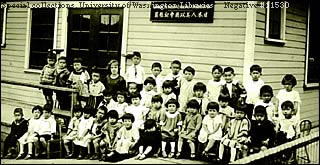
III. Classroom Activities
The following activities use this document packet along with other suggested materials.
1. Before even beginning with the curriculum materials, ask students why there are Asian Americans in your town. Then, take your local phone book and find several common Asian American names (e.g., Nguyen, Locke). Ask students what they notice about the names listed —where they live, their first name, how many there are—in the book. Ask students if they know of Asian Americans that live in their neighborhood. (You can also use the Yellow Pages to find Asian-owned businesses.) The question of why and how Asians came to live in Washington state today links the documents to the present.
2. Using the maps in the packet, divide students into groups. Students can ask why Asian groups immigrated to the United States; what region of the U.S. contains the largest Asian American population; and what Asian American groups live where and in what numbers. Then ask students to find documents that could help historians to make such a map.
3. Hold a debate on immigration policy, either in the present or based on historical documents. Divide students into groups, then assign them positions either for or against Asian immigration. You can have them debate the 1882 Chinese Exclusion Act; or they can discuss restricting immigration today. You might want to have some students play immigrants, pleading their case.
4. Have students uncover their own immigrant past. Ask them to research their family history and create a genealogy or family tree. Have them include interviews with family members, together with family stories, in their project. Students can share their immigrant past with the class, opening discussion as to who came to the United States, when, from where and why.
5. Hold another debate—this one on the internment of Japanese Americans during World War II. Have students play historical actors—Gordon Hirabayshi, General J. L. DeWitt—and ask them to defend or attack the removal of Japanese and Japanese Americans from the West Coast in 1942.
6. Using the immigration documents, chart the path of how immigrants enter, work, and become citizens of the United States. Ask students to reenact this process; another role playing game using the materials in the packet.
7. Ask students to create an imaginary travel brochure selling the United States to potential immigrants. This brochure might emphasize jobs on the railroads or in salmon canneries. Then ask other students to develop a warning to potential immigrants, highlighting the problems with racism, physical violence, and separation from loved ones.
8. Have students study the demographic data from the maps and charts, asking them to discuss different ways of presenting statistical information. Then, find statistics from the 1970, 1980, and 1990 Census Reports for Washington state (or the United States), and ask them to graph the data and interpret the results.
9. Ask students how they define themselves. Have them create a name describing their identity (e.g., Chinese American, Norwegian American). Write this name on a sheet of paper, which they wear as a label, then have them introduce themselves to one another, explaining what their identity means. Afterwards, discuss what positive and negative things we associate with labels that people give themselves.
10. Compare the experiences of men and women, or of different immigrant groups, using the documents. Students can choose documents from one group or another and write imaginary letters home, diary entries, or poetry, trying to speak as a representative from a particular group describing their experiences.
11. Write a news story about a significant event involving Asian Americans in Northwest history—the expulsion of the Japanese in 1942, the anti-Chinese "riots" in Seattle and Tacoma, the election of Gary Locke as Washington state governor, to name a few suggestions. Then, ask them to deliver their story to the class, television style, followed by a discussion.
12. Ask students to name prominent Asian Americans, nationally and in the Pacific Northwest. Then assign students to research their history, background, and contributions.
| Main Page | Section II | Section IV | Section V | Section VI |